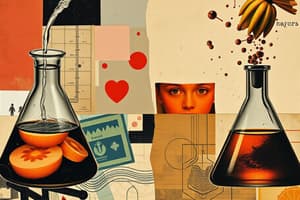Podcast
Questions and Answers
Which of these are different types of evidence of chemical reactions? (Select all that apply)
Which of these are different types of evidence of chemical reactions? (Select all that apply)
- Color Change (correct)
- Formation of a Precipitate (correct)
- Formation of Gas (correct)
- Temperature Change (correct)
- None of the above
What is it called when two liquids form to become a solid?
What is it called when two liquids form to become a solid?
Precipitate
What happens to molecules when you raise the temperature of a system?
What happens to molecules when you raise the temperature of a system?
They bounce around more and have more energy.
How does increasing concentration affect the rate of a chemical reaction?
How does increasing concentration affect the rate of a chemical reaction?
How can surface area affect the rate of a chemical reaction?
How can surface area affect the rate of a chemical reaction?
What is the role of a catalyst in a chemical reaction?
What is the role of a catalyst in a chemical reaction?
What do inhibitors do in a chemical reaction?
What do inhibitors do in a chemical reaction?
Formation of a smell is NOT evidence of a chemical reaction.
Formation of a smell is NOT evidence of a chemical reaction.
Can a reaction have more than one evidence?
Can a reaction have more than one evidence?
The more molecules that collide together, the more it increases the rate of a chemical reaction.
The more molecules that collide together, the more it increases the rate of a chemical reaction.
Flashcards are hidden until you start studying
Study Notes
Evidence of Chemical Reactions
- Types of Evidence include color change, formation of a precipitate, formation of gas, and temperature change.
- Color Change: Indicates that substances often undergo color transformation during a chemical reaction.
- Precipitate: A solid formed when two liquids react; this solid is a key indicator of a chemical reaction.
Factors Affecting Rates of Chemical Reactions
- Temperature: Increasing temperature enhances molecular energy, leading to more frequent and intense collisions between molecules, thus speeding up the reaction.
- Concentration: A higher concentration results in more particles in a system, increasing the likelihood of collisions and accelerating the reaction rate.
- Surface Area: Increasing the surface area of solid reactants exposes more particles to collisions, enhancing the rate of reaction as more particles interact with one another.
Role of Catalysts and Inhibitors
- Catalysts: Substances that lower the activation energy required for a reaction, facilitating faster reactions without being consumed.
- Inhibitors: Compounds that slow down or halt chemical reactions, allowing for more controlled processes and preventing the depletion of reactants.
Miscellaneous Facts
- Formation of Smell: The emergence of a smell is considered evidence of a chemical reaction.
- Multiple Evidence: A single reaction may exhibit multiple forms of evidence, signifying its occurrence.
- Molecular Collisions: An increase in the frequency of molecular collisions directly correlates with an increased rate of chemical reactions.
Studying That Suits You
Use AI to generate personalized quizzes and flashcards to suit your learning preferences.




